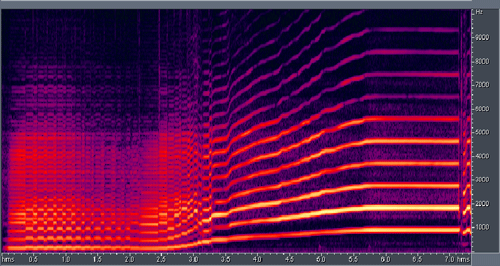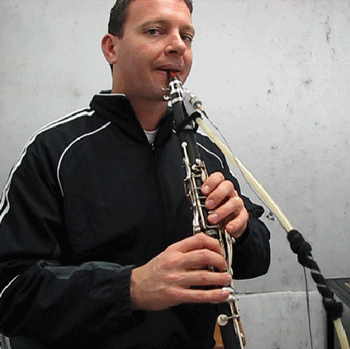


How to play the first bar of Rhapsody in Blue
Jer-Ming Chen (jerming@phys.unsw.edu.au)
John Smith (john.smith@unsw.edu.au)
Music Acoustics, School of Physics, UNSW
Popular version of paper code 2aMUb6
"How to play the first bar of Rhapsody in Blue"
Presented Tuesday July 1, 2008 at 1:40 p.m. at Amphi Maillot, Palais des Congrès de Paris
Background
The two-and-a-half octave solo clarinet glissando opening Gershwin’s Rhapsody in Blue (Figure 1) is one of the great icons of 20th century music and one of the best known bars in music. Commissioned for an “experimental concert” by Paul Whiteman and his jazz orchestra, Rhapsody premiered with Gershwin on the piano. It was not until rehearsals of the Rhapsody began that the glissando unintentionally came into being: “...as a joke on Gershwin, Gorman (Whiteman's virtuoso clarinettist) played the opening measure with a noticeable glissando, adding what he considered a humorous touch to the passage. Reacting favourably to Gorman’s whimsy, Gershwin asked him to perform the opening measure that way at the concert and to add as much of a ‘wail’ as possible.”[1] At its première (Feb 12 1924 at New York’s Aeolian Hall), “Ross Gorman began his glissando and electrified the house”[2]. This performance tradition has continued to delight audiences ever since.

Figure 1. Opening of Gershwin’s “Rhapsody in Blue” showing the two-and-a-half octave solo clarinet run, as it is written – but not as it is usually played.
Replicating the Act
Replicating Gorman’s ‘wail’ (heard here [3]) is now standard performance practice, but is a difficult act to follow. To achieve this effect, expert players combine unusual fingerings with even more unusual configurations of their vocal tract to achieve a nearly continuous rise in playing pitch (Figure 2). To study the two mechanisms in detail and understand how they interact, 5 experienced clarinettists were engaged (4 professional players, 1 advanced student) to play on a Bb Clarinet (Yamaha model CX).

Figure 2. A spectrogram of the glissando plots frequency (vertical axis) against time, and sound pressure as brightness. The lowest line on the graph is the fundamental frequency f, which gives the playing pitch. The opening trill on the note G3 is executed from 0 to 2 seconds and a scale-like run at 2.5 to 3.5 seconds. Thereafter, the pitch rises smoothly over an octave from C5 (3.5 seconds) to the sustained note at C6 (beginning at 5.7 seconds). Note names are in clarinet written pitch.
*An interesting feature of clarinet sound is that, for some of the lowest notes, the lowest even harmonics are weaker than the odd. Over most of the glissando range, however, there is little difference between even and odd harmonics. For an explanation, see http://www.phys.unsw.edu.au/jw/flutes.v.clarinets.html .
We first measured the clarinet’s resonances for various fingering positions used in the glissando (method described here [4]). This was followed with a novel technique to study the player’s vocal tract non-invasively (described here [5]): a sound source and a microphone were incorporated into a clarinet mouthpiece, allowing us to “look” into the player’s vocal tract without disturbing the player and so measure its resonances as they perform (Figure 3). The clarinettists were asked to play the glissando and “pause” for a few seconds at various points in the run while we measured their vocal tract resonance at that configuration. We then compared the vocal tract resonances with the corresponding clarinet resonances for the fingering used at that playing pitch.

Figure 3. Francesco Celata (Sydney Symphony Orchestra) plays on the clarinet setup.
Clarinet Resonance and Fingers
Seven of the tone-holes on the clarinet are covered directly by the fingers rather than key pads. Thus the player can gradually uncover the holes by progressively sliding the fingers off the clarinet. Measurements of the clarinet’s resonance at various stages of finger-slide positions clearly show the intermediate resonances created as the finger gradually slides off the holes. Over part of the instrument’s range, this contributes to the smoothly increasing playing pitch (instead of jumping in discrete ‘steps’ like a normal musical scale). But it is only part of the story.
Clarinettist’s Vocal Tract Resonance
The frequency at which the clarinet reed vibrates determines the pitch of the note played. That frequency is determined by a combination of the resonances in the bore of the instrument and the resonances in the vocal tract of the player. Usually, the clarinet’s resonances dominate and the player’s tract has only a minor effect. However, the final octave of the glissando (from C5 to C6) lies in a range of the clarinet where the clarinet resonances are weaker. In this range, experienced players can produce very strong resonances in the vocal tract comparable with or larger in magnitude than those in the clarinet: the vocal tract can ‘win’ the battle to control the reed. By tuning this resonance of the vocal tract, expert players can control the playing pitch continuously.
The glissando in Rhapsody in Blue requires a strong vocal tract resonance and smooth control over a large pitch range. However, the playing pitch need only deviate from that of the fingered note by a semitone or so. Greater deviations are possible: in other experiments using a single fingering, we measured the resonances of the player’s tracts as they shifted the pitch by several notes, using the vocal tract alone.
Summary
In the clarinet, the reed’s oscillation determines the sounding note. Downstream from the reed is the clarinet bore, while the player’s vocal tract is upstream. For normal clarinet playing, downstream resonances in the clarinet bore (determined by the fingering used) dominate to drive the reed to oscillate at a particular frequency. However, if the upstream resonance in the player’s vocal tract is adjusted to be strong enough and at the appropriate frequency, the vocal tract resonance will then compete with the clarinet resonance to determine the reed’s playing frequency. (Occasionally the reed resonance wins, and we hear that as a squeak!)
By skilfully coordinating the fingers to smoothly uncover the clarinet finger-holes and simultaneously tuning strong vocal tract resonances to the continuously changing pitch, expert players are able to facilitate a smooth trombone-like glissando, particularly in the final octave of the run.
References
[1] Charles Schwartz, Gershwin: his Life and Music, 81-83, Da Capo Press (1979)
[2] David Schiff, Gershwin: Rhapsody in Blue, pp. 60, Cambridge University Press (1997)
[3] Gorman’s rendition can be heard here : Paul Whiteman and his Orchestra (Gershwin at the piano), recorded 10 June 1924, New York, New York, Victor 55225-A & B http://www.redhotjazz.com/pwo.html (accessed 10 June 2008)
[4] Dickens, P., Smith, J. and Wolfe, J. (2007) "High precision measurements of acoustic impedance spectra using resonance-free calibration loads and controlled error distribution", J. Acoust. Soc. America, 121, 1471-1481.
[5] Chen, JM. Smith, J. and Wolfe, J., (2008) “Experienced saxophonists learn to tune their vocal tracts”. Science, 319, 726.